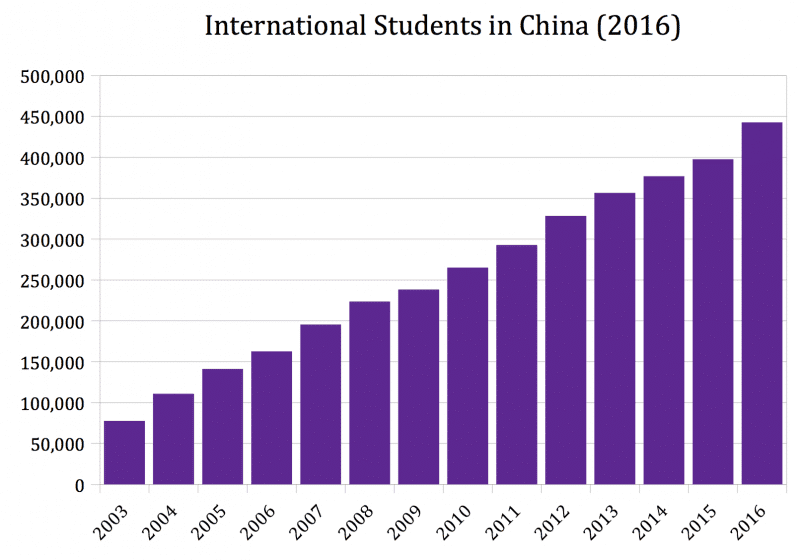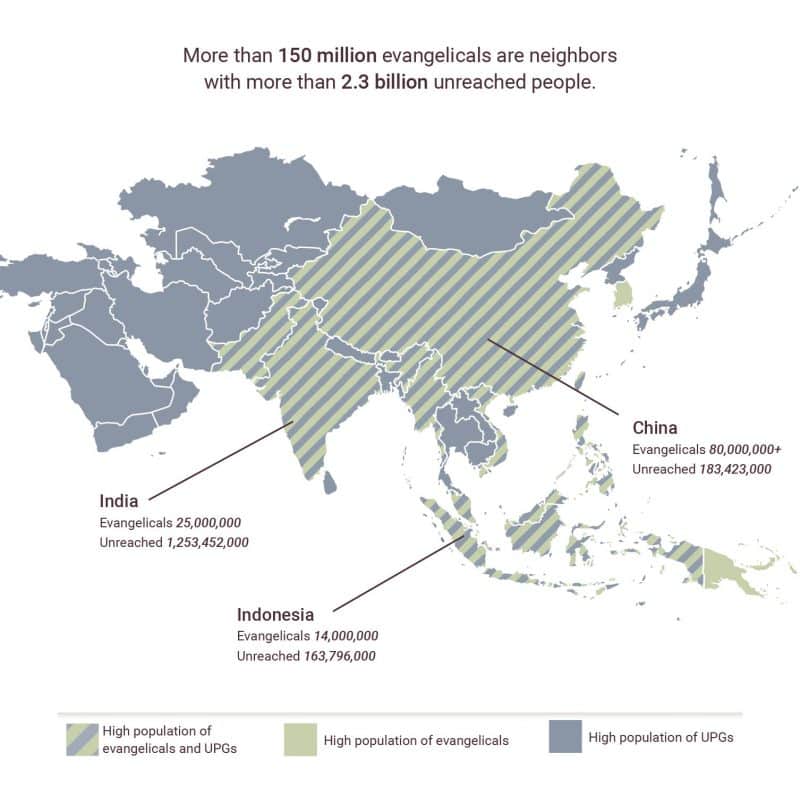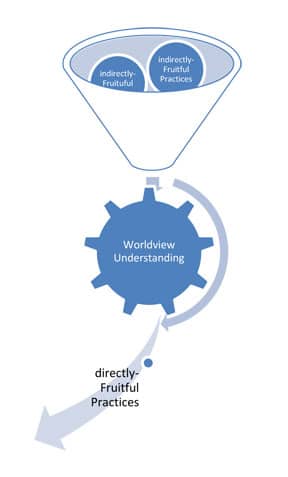The Break Through Process: Reflections of a Missiological Field Research Coach
by Stan Nussbaum
A simplified, yet thorough method for small-scale and personal research in missions.
Every mission practitioner worthy of the name desires to become more fruitful in his or her ministry, but very few see field research as a workable route to fruitfulness. They either do not see the practical value of research, or they do not think they are capable of it. Unless they take some years out to do research for a graduate degree, they simply cope as best they can without attempting any field research at all.
This is a tragedy, limiting the mission harvest in countless ways. We are sending the harvesters out into the ripe fields with pocket knives instead of scythes. Or to change images, we are graduating illiterates from our mission training centers. They are not illiterate in terms of books, of course. We meticulously train them to read and analyze written documents, but we never give them a day’s training in how to “read” a situation. They do not know the ABCs of field research—how to turn a prayer request into a research question, what to ask people, how to ask it, whom to ask, how to draw insight from the responses, and how to apply the insights to ministry.
One of the delights of my life has been the privilege of developing the “Breakthrough” process, a type of non-formal education that equips ordinary practitioners with these ABCs (Nussbaum 2011). In effect, it is a miniature version of a DMin or DMiss project. The development, under the auspices of GMI Research Services, has involved coaching expat and local mission practitioners over the last twenty years by email and in a variety of classroom and tutorial settings in places like England, Peru, Malaysia, Egypt, and Burundi.
The Breakthrough definition of field research is:
Asking the right questions to the right people in the right way in order to gather information that provides fresh insight leading toward creative recommendations and actions according to God’s will and for his glory. (cf. Phil. 1:9-11)
I offer the following reflections on my ups and downs in coaching. If hindsight is 20/20, these may be useful to others who long to see more fruit in their mission activities.
The Great Disconnect
The heart of the Breakthrough process is the “Master Worksheet,” which was developed very early and has proved its value repeatedly. One American worker at a respected mission training center commented, “I got further on defining my research topic by filling out that one page than I had in the previous three months of classes, library work, and discussions with my advisor and fellow students.”
The “great disconnect” between mission practitioners and missiological field research is the disconnect between 4 and 5 on the Master Worksheet (see page 335). Practitioners easily fill out steps 1-4 because they are describing experiences in familiar ways. Then things fall apart.
Practitioners who do not know the ABCs can rarely manage the jump from 4 to 5, which is the bridge from a ministry concern to a research project (in most MA or PhD projects, a literature review replaces steps 1-4 and provides the foundation and framework for step 5). They often write two action questions or two insight questions instead of one of each. They simply do not see the connection between item 4, “What does God want me to do?” and item 5, “What could I understand better about my situation that might help me realize what God wants me to do?”
Their typical way of wrestling with item 4 is either to continue doing what they were doing (and perhaps pray harder about it) or to experiment with some adjustment they hope may be more effective. They also pray for God’s guidance. Breakthrough invites them to take the new step of recognizing that research can be interwoven with prayer, enabling them to see things from new angles, pray in new ways, and make adjustments better aligned with God’s will.
For example, a Nigerian missionary in Kenya was trying to mobilize pastors in combating child abuse. His impression after some months of mobilization efforts in the community was that the pastors were taking the issue lightly. He wanted them to share more of his passion about the problem. When he interviewed several pastors for his Breakthrough research project, he found that they were far more open than he thought. Many were simply unaware of some basic facts and unsure what steps to take.
He became less judgmental and more helpful, less discouraged by the uninterested pastors and more focused on the cooperative ones, all because his mind was no longer clouded by negative questions like, “What is wrong with you pastors? Why don’t you see how serious my issue is?” When I see researchers’ hearts change like that, I am convinced that the Lord is in it.
The Great Discoveries
Let me share six key points in the Breakthrough process.
Personal experience. If there is one main thing I have learned from two decades of research coaching, it is that I cannot convince a researcher of anything, no matter how strongly I emphasize it in the Breakthrough manual or during the workshop. Researchers must convince themselves, and by God’s Spirit at work in them, they do.
For example, an American working in Venezuela did Breakthrough research to determine why a project he worked hard on had melted away to nothing after a few months. As he interviewed Venezuelans, he discovered so much about their perspective on learning that he decided to change his whole approach to dreaming up projects. Instead of sitting in his study drawing up the “perfect” plan, and then going out to implement it, he would seek out valuable Venezuelan input much earlier in the planning process. A simple lesson? Perhaps, but one that transformed his style of mission and consequently the Venezuelan attitudes toward him.
Preparing quality questions. The central skill Breakthrough teaches is preparing quality questions. A learning game called the “TEACUP Olympics” has worked well to communicate the six “TEACUP” criteria of a good question—tolerable, essential, answerable, clear, unbiased, and penetrating. One judge is assigned for each criterion, and the panel of judges scores the questions of “contestants” one at a time (cf. Skott and Ward 2013, 71-75). Stated more clearly, one contestant sits on the “hot seat” and presents one of his or her questions to the panel. Before the judges reveal their scores, the rest of the class writes down their own guesses on what the scores will be.
Asking smaller, more direct questions. The most common mistake untrained researchers make when trying to solve something is what I call “shooting from midfield” (a phrase used in soccer, when trying to score by kicking the ball at the goal as soon as one crosses the midfield line). What researchers think they should do is ask either their “insight question” (“What is wrong?”) or their “action question” (“What should we do about it?”) directly to the respondents. In effect, they are asking other people to solve their research problem for them.
When this happens, typically a small number of predictable answers come forth, none bringing any new insight to the issue. Breakthrough training helps researchers find ways of breaking their big question into several smaller questions respondents can handle.
For example, an Indian mission trainer would have been shooting from midfield if she had asked her former students, “Why don’t you plant churches the way we trained you to instead of trying to recreate churches that look like your home church?” Instead, she asked smaller questions: Were the trainees not understanding the training in the first place? Did they understand it, but not believe in it? Did they believe in it, but not know how to apply it in a new situation? Her discoveries were appreciated so much by the directors of her training center that they postponed the next intake of students so she and her colleagues could retool the center’s curriculum.
Context and story. Unfortunately, first-timers may equate field research and survey. This makes the prospect of “research” far more intimidating than it needs to be. Survey is the most difficult method for first-time researchers, and it can be woefully deceiving if they get it wrong.
Furthermore, the survey method is severely limited in global usefulness because it is based on a Western premise—that an idea can be communicated without a context. A survey question avoids describing a context in order to isolate and measure a single variable. This is very tricky even in Western cultures, but in the Global South it is a lost cause. Researchers can rarely formulate such questions and respondents cannot meaningfully answer them. Questions, responses, and data interpretations are flawed.
In Global South settings, I encourage researchers to add context—exactly what Western research textbooks advise against. For example, I promote “suppose” questions like: “Suppose you are in a community meeting where X is being discussed. Someone says A, someone else says B. Which view do you think the meeting will support: A a lot more than B, A a little more than B, Both equally, B a little more than A, B a lot more than A?”
Over the years, I have put less and less emphasis on the survey method, and I never touch the subject of statistics. The aim of Breakthrough is to equip entry-level researchers to do what is possible with simple percentages and usually without cross-correlating any answers.
The interview method allows more opportunities for the researcher to realize when a question is being misunderstood. I encourage “story questions” in interviews: “Do you remember ever being in a situation in which….Tell me about it.” The respondent starts telling a personal story, which is much easier than rating things on a scale or stating a personal opinion without knowing whether others agree with it. As the respondent relaxes, insight leading toward truth is more likely to ease into view. Of course, story data is trickier for the researcher to analyze than survey data, but tentative conclusions from stories are more helpful than the deceptive precision of a flawed survey.
Evaluative research. One of my Kenyan students noticed that two New Testament translations his agency had painstakingly produced were not having the expected impact on the health of the churches after a couple of years. Meanwhile, his agency had five other New Testament translation projects underway in his region. When complete, would they turn out to be a massive waste of time and money?
How carefully do mission agencies typically check the value of the first two projects before they invest in the next five similar ones? How many mission funding decisions are based on impressions and/or wishes, rather than on field research? Is it worth $1,000 to do research that will affect how $100,000 will be allocated?
Actionable, reliable results. Academic research is often aimed at definitive conclusions. Therefore, researchers spend a long time digging deeply into a very small topic. By contrast, Breakthrough research looks quick and dirty. The sample groups are too small to be definitive and the research is too brief to provide “assured conclusions.” However, Breakthrough’s aim is more to generate insights that will advance a discussion than to reach a conclusion rendering all further discussion unnecessary.
For example, an Egyptian researcher observed in just a couple of years a drop from 180,000 to 120,000 children in his organization’s summer Bible School program for children in poor communities. He did not have the resources to attempt a scientific sampling of that group and all its sub-groups, but he could do a small Breakthrough project and test a couple of theories he had about traditional teaching methods that were out of touch with today’s children.
What he learned enabled him to spark a more serious organizational discussion of the issue than he could have with a theory alone. He proposed experimental changes in teacher training. These may not have been as well designed as if he had spent four years on a doctorate with a scientific sampling of the 120,000 children, but the weaknesses in his design could be worked out by monitoring the results of his proposals. The point is that he got some actionable, reasonably reliable results in the short term with the available resources.
The Great Disappointment and Challenge
Personally, the most surprising thing about the Breakthrough resource is that even though there are now many “satisfied customers,” and even though it has become a required part of one international program with about eight hundred MA students at any one time, the idea has still not caught on widely with the main group I wanted to help—ordinary mission practitioners.
I designed a method of non-formal, on-the-job, continuing education and made it available at www.gmi.org. However, it has been adopted mostly as an ordinary college or graduate course for academic credit, taught as a workshop followed by email supervision. Unless people are taking the course for credit, their typical response when they hear of the Breakthrough concept is, “That’s really interesting,” or “That would be great”; however, in the real world people never find time to do things that are merely interesting. They must have a compelling reason that will benefit them directly and justify their investment of time and money. This reality creates a Catch-22 situation for Breakthrough training. People only discover how beneficial field research is when they do it, but they are not motivated to do it unless they can foresee its benefits.
The training director at one large mission agency discovered who in her organization could solve this problem. It was not the president, the research department, or herself; instead, the regional and country directors were the ones in a position to recognize the value of research because they knew where their field workers were stuck or where they were facing complex, new opportunities. They could identify which workers had research aptitude and were in a position to allocate a worker’s time via an instruction such as, “Please research issue X on behalf of the team and write up three or four pages with recommendations for us to discuss at our annual planning meeting.”
An instruction like that bypasses the Catch-22 and alleviates two assumptions: (1) realistically, there will never be time for research except during home leave and (2) Breakthrough research is “continuing education,” always a low priority. In other words, the potential for the Breakthrough approach to catch on in mission agencies may depend on it being seen not as something for the training department or the research department, but as part of the strategic planning led and driven by the regional and country directors.
Conclusion
The Great Commission implies a need for small-scale, up-close, and personal research. The better we understand the people we are trying to bring into the Kingdom of God, the easier it becomes to make disciples of them. It will never be easy, and research is not a magic solution, but I have seen over and over that it does help disciple-makers understand what God wants them to do differently or to do next in their ministries. New prayers are prayed, new conversations start, and new fruit is produced. God is glorified and the missionaries have new God-stories to write home about.
Master Worksheet for the “Breakthrough” Process
1. CONCERN. An area where I/we need a ministry breakthrough is… [state in eight words or less]
2. OBSERVATION. This area of concern is on my mind because in my ministry I have noticed that…
3. PRAYER. My prayer for a breakthrough in this area is that God would…
4. ACTION QUESTION (“practical question”). I need to know what God wants me/us to do next about this part of my/our ministry. The specific action question I/we need to resolve is…
Note: Your action question may start with a phrase like, “Should we,” “How should we,” or “What could we.” An action question is a question about you. The “insight question” (below) will be a question about “them,” the people you are going to research.
5. INSIGHT QUESTION (“central research question”). As I seek God’s guidance about this action question (# 4), I will also seek deeper insights into the people and the situation I am concerned about. The thing I/we need to understand better is…
Note: Your insight question may focus on people’s behavior, values/beliefs, motivations, or some combination of those levels. It may start with a phrase like, “What do people think,” “How can it be that, “Why do,” or “Why don’t.” Remember that your insight question is the most important question you will write in the entire Breakthrough process. It will guide and shape your whole project.
6. HYPOTHESES. Some possible answers to my insight question (# 5) are…
References
Nussbaum, Stan. 2011. Breakthrough! Prayerful Productive Field Research in Your Place of Ministry, 2nd ed. Colorado Springs, Colo.: GMI Research Services.
Skott, Beth P. and Masjo Ward, eds. 2013. Active Learning Exercises for Research Methods in Social Sciences. Los Angeles: SAGE Publications.
…
Stan Nussbaum is staff missiologist of GMI Research Services and a research trainer for Development Associates International, having previously served in England and Southern Africa. He is author of Breakthrough: Prayerful Productive Field Research in Your Place of Ministry.
EMQ, Vol. 50, No. 4, pp. 332-339. Copyright © 2014 Billy Graham Center. All rights reserved. Not to be reproduced or copied in any form without written permission from EMQ editors.






